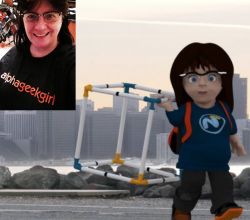Author: Debi
Viewing modo601 help docs in pdf format on your iPad
| Description | The modo 601 documentation has at least three times as much content as previous versions. And you'll be fascinated by some of the hidden gems you'll find there. So reading the modo docs on your iPad is a great way to kill time whilst being productive - especially when you don't have a paperback with you, or internet access. And five minutes a day discovering something new is more worthwhile than playing games 😉 Note: MODO701 does not come with a .pdf version of the help docs |
||
|---|---|---|---|
| Step-by-Step |
|
||
Organic, low-poly built-in mesh presets
| Description | Ever needed a low-poly bird for a background, or wanted to sculpt an organic shape like an animal or human but didn't want to start totally from scratch? Did you know modo has them built-in? They're part of the Solid Sketch menu. The Solid Sketch tool provides a quick method for “roughing” out organic shapes. By clicking down, new nodes are created and Solid Sketch connects these dots with a smooth flowing mesh. Each node can spawn new branches to create complex shapes quickly and easily. When you click to create a node you can immediately drag to the right and left to scale the node. Once you have released the mouse button you can use the various handles to move, scale, rotate and twist the node. Additionally, holding the Shift key and dragging on the center handle will scale on all three axes. Clicking on a node with the middle-mouse button will delete that node. Note: It seems for some reason that this functionality has been removed from MODO701. |
||
|---|---|---|---|
| How? |
 Go to > Geometry > Curve Palette > Presets |
||
Creating Custom Sliders for Morph maps
| Description | Once you've created a variety of morphs for your character's facial expressions, creating "sliders" by using the channel haul tool and custom user-channels, will enable you to quickly animate your character's face, by simply transitioning between their various poses. When I first looked at writing a Step-by-Step for this, I was basing it on Ryan Drue's video back from the 401 days on Lux TV. Naturally, I was expecting this to have changed slightly (as I am writing this during 601 SP5). But halfway through I got stuck because the interface had since changed. So I had to go to the forums for help. Within an hour or so, I received two responses - one from modo mio, who gave me the answer I wanted, and then Clef took it one step further and gave me the answer I needed by creating an updated video using the newer schematic view. So this article is kind of a hybrid of all three approaches but hopefully the simplest way. |
||
|---|---|---|---|
| Step-by-Step |
Note that this article does not cover the actual creation of your morph maps. It assumes you have already created them or else, you're using a mesh such as the Old Man Head (part of modo's standard Content), which comes with its own set of facial morph maps.
Create Morph Influence
Create Locator & set how it's displayed  Create User Channels Link User Channels
Connect Face Controller to Channel Haul
|
||
| Source | You can watch the original video by Ryan Drue created for modo 401 (Old Luxology Forums - no longer exists) Later on when 601 came out, there were questions on the forum about how the workflow had since changed where Clef and a modo mio responded And this is Clef's video using the schematic view |
||
| Credits | Ryan Drue, a modo mio, Clef | ||
Related Images:
Creating directional constraints for eyes
| Description | When rendering out characters, most times it's preferable to have them looking straight at the camera. But you may need to move the camera around quite a bit so that you can get just the right angle, which means, you will need to keep manually adjusting the eyes so that they continue to look towards the camera. There is a way though that you can constrain the eyes to remain fixed on a particular spot (locator). That way you can then move the locator anywhere around and the eyes will follow, making it a lot easier for you to set up your shot. If however, you move the locator really close to the eyes, they will go cross-eyed, so using a central controller can help deform the eyes in a non-destructive manner. |
||
|---|---|---|---|
| Step-by-Step |
Prepare eyesSetup Tab |
||
| Source | You can watch a video that details the process here | ||
| Author | Daniel Ripley - cgdreams.co.uk | ||








 100%
100%






